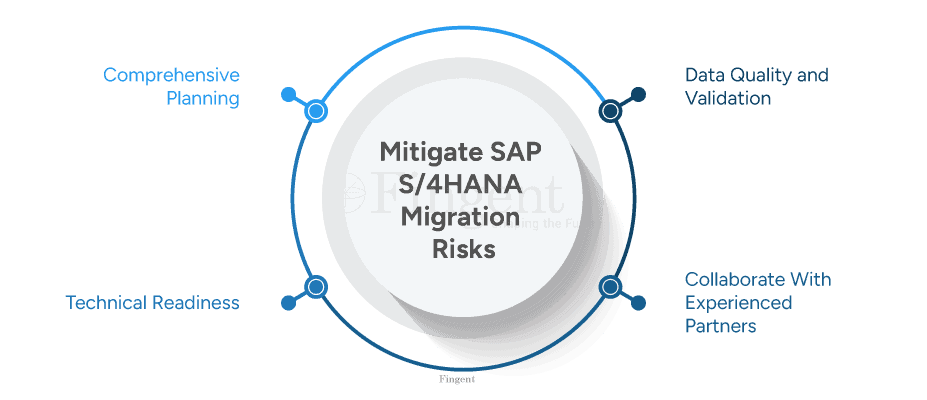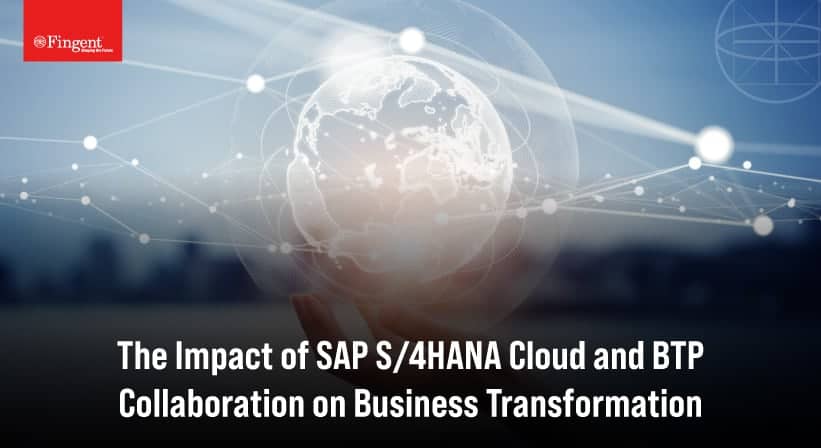Navigating SAP S/4HANA Migration Risks For Seamless Transformation
SAP ECC is ending support in 2027, leaving leaders with one choice: migration to SAP S/4HANA. This strategic move promises business benefits like improved operational efficiency and advanced analytics. Although, the many advantages, the path to migration is fraught with many risks and challenges. What are these critical risks, and how can leaders prepare to mitigate them for a successful transition? This blog will help you explore the top ways to navigate SAP S/4HANA migration risks.
Drive Business Excellence with Pathbreaking SAP Solutions
An Introduction to SAP S/4HANA
The SAP S/4HANA system is modern ERP software that runs on the SAP HANA in-memory database. This enhances the system’s ability to process transactions faster and provides real-time reporting capabilities. It also has three modes of deployment: private cloud, public cloud, or on-premises.
S/4HANA also works effortlessly with older SAP programs as well as external systems. It connects all departments within the organization, ensuring smooth operations. The tools provided by the S/4HANA system will help organizations stay competitive with an upper hand.
Why is it Urgent to Migrate to SAP S/4HANA?
The digital world keeps progressing with impeccable speed. To stay significant in the current market, companies must adapt to upcoming trends. Listed below are some of the main reasons why migration to S/4HANA is an urgent matter:
1. End of Support for ECC
Companies currently using SAP ECC have no choice but to migrate to SAP 4/HANA. SAP has declared to end mainstream maintenance for SAP ECC by 2027. This means SAP will no longer offer regular updates, support, or security for ECC systems. Migrating to S/4HANA can help businesses stay relevant with effective operations and growth strategies.
2. Technological Advancements
In-memory computing processes data much faster than legacy databases. This enhances real-time analytics and reporting. The new simplified model is designed to reduce the complexity and size of the software database. This improves performance and cuts the cost of ownership. The advanced user interface for SAP 4/HANA also offers an intuitive and interactive experience.
3. Business Benefits
S/4HANA also offers real-time insights and integrative analytics. Its enhanced data processing causes real-time analytics. This enables organizations to make quicker and more informed decisions. It also has extra features, such as integrative analytics and machine learning. They enhance the company’s predictive capabilities.
4. Integration with Innovation
S/4HANA can integrate with existing SAP products seamlessly. This fosters innovation. Further enabling the optimization of emerging technologies like IoT, AI, and ML.
5. Cost Efficiency
S/4HANA opens up a plethora of long-term reduced-cost benefits. From reduced infrastructural costs to lower maintenance costs, it can lead to significant savings.
Choose SAP Solutions That Cater To Your Unique Business Ecosystem
What is the Difference between S/4HANA Conversion and Migration?
S/4HANA migration means transferring transaction data into another system. During this process, pre-project adjustments are not necessary. It is generally referred to as the Greenfield or Selective Migration Approach. It involves the setup of a new system and the migration of the initial data load.
System conversion, on the other hand, refers to converting an existing system. For instance, it could mean converting an SAP ECC system into an SAP S/4HANA system. This approach is also called the Brownfield Approach. Here, pre-project preparations are necessary. These preparations include data migrations and software customization.
Read more: Various Paths to SAP S/4HANA Migration – A Detailed Guide
What are the Challenges of Migrating to SAP S/4HANA?
With S/4HANA, companies can upgrade their IT infrastructure and boost business operations. Yet, this process comes with its fair share of challenges. These include change management, customizations and integrations that need careful handling, the need to maintain data integrity during transfer and more. Let’s discuss some of the challenges here. Following, you will read how to mitigate these S/4HANA migration risks.
1. Gaining Support from Senior Management
This is a crucial step during the migration process. It involves requesting the necessary resources and budget allocations. You will have to make promises about advancement’s alignment with business goals. Persuading stakeholders about the necessity of migration is challenging.
There must be effective communication about the technical requirements and the migration process. Emphasize the positive outcomes. Elaborate on how the investment will have cost-effective benefits in the long run. Draw attention to the enhanced efficiency, improved integration, and futuristic IT infrastructure.
2. Maintaining Effective Controls
During the migration process, many customizations and integrations are underway. These processes need to be handled carefully to ensure a successful migration. This step involves identifying potential risks and developing effective ways to mitigate risks. It ensures that the migration process is carried out safely and minimizes the chances of any adverse impact on operations. Furthermore, managing controls can protect data integrity throughout the migration process.
3. Data Migration
This is the main step in the SAP migration process. It involves transferring large volumes of initial data from one system to another. Data integrity is the top priority, followed by accuracy and consistency. Any mishap in this step could cause a recurring issue throughout the organization. Creating a strong migration approach is important for a seamless transition. This includes planning the data extraction, transformation, and loading processes.
Developing a data-centered framework that automates workflows is also important. It is well-advised to delete old data from the legacy system before the migration process. Skimming through the legacy system to delete any unnecessary data is crucial. This will help optimize the transaction data. Furthermore, it reduces the risk of migrating inaccurate information.
4. Change Management
Also known as dual maintenance, this term describes managing changes across landscapes. The complete transition will take time. Most companies cannot afford to pause their business operations. Here, it becomes vital to deliver changes across many landscapes seamlessly at the same time. It is crucial to ensure that S/4HANA landscapes mirror any changes made in the legacy systems. Dual maintenance can be a tiring task, but it is a necessity.
5. Custom Code Adaptation
The Custom Code developed by SAP requires many technological modifications. This way, the system software will be compatible with the S/4HANA system. Modification of custom code requires a thorough assessment. Check your legacy system for any incompatible codes. These are usually no longer within your productive business applications. This guarantees the utmost functionality and eradicates any potential post-migration problems.
What is the Biggest Risk when Performing a Database Migration?
Every project has its fair share of risks to look out for. The biggest risk for a S/4HANA migration project is data loss. Losing crucial data can cripple a business, so that is something that needs to be cared for. There are other risks involved as well that have the potential to crumble the project and stunt business operations. Listed below are some of the major risks to keep an eye out for:
1. Data Migration Challenges
The data migration to the S/4HANA process is the more risk-prone stage. The entire process is extremely complex. Consisting of high risks such as data loss, corruption, and compromised data integrity. These issues appear with differences in field gaps between legacy systems and S/4HANA.
2. Poor Planning and Migration Strategy
Ensuring you have an ironclad migration strategy is crucial. Without a proper plan, you may face delays, cost overruns, and data issues. Careful planning will ensure the mitigation of any irrelevant datasets.
3. Technical and Operational Risks
Technical risks, such as integration issues and incompetence in infrastructure, arise during migration. Evaluating your organization’s readiness for migration is a precaution. The proper implementation of appropriate tools must be a priority. This will have a direct impact on business operations and service levels.
4. Customization and Compatibility Issues
Companies are bound to get attached to their legacy system customizations. Especially when these systems have been running for many years. S/4HANA cannot always support these deep customizations. For example, an ABAP source code must be modified to the SAP code. This can sometimes become backward compatible and counterproductive.
5. Lack of Expertise
The migration process becomes complex with heavy data and many technical tools. The company then needs to hire professionals to do the job. This is not always a pocket-friendly option and may sometimes exceed the budget.
Master SAP S/4HANA Transformation! Know the Benefits, Impact, and Strategies To Success.
What are the Risks of Server Migration with the S/4HANA System?
The most common risk is the change in file structure on the application server. Regardless of the approach, most companies encounter this problem. This is due to a lack of professional experience with migration. As a consequence, organizations fumble and buy expensive extensions to the project.
Check the validity of the entries before migrating to technical roles. SAP programs read and write data on the file system to check the authorization of objects. Verifying the validity of these entries before the migration process will help mitigate the risk to the application server.
When you change migrated files, the termination of the program is prevented. These invalid values in authorization get stored as a short dump. This problem needs to be resolved before further testing. This could put the entire migration process on hold. Even system administrators have to work extra hard to analyze and correct such issues.
Strategies to Execute Safe and Seamless Migration
Organizations can install effective migration strategies during their S/4HANA migration process. These steps will make the process much smoother and help mitigate the S/4HANA migration risks.

1. Comprehensive Planning
Planning should start with closely reviewing the organization’s current IT infrastructure. This will help you understand the scaling and parameters of the migration process. The next key step on the list is risk assessment. It will help you be prepared for any challenges that come your way. Assess all your options and select the right migration strategy for your organization. This is the first step in the migration process. An effective S/4HANA migration strategy must include a detailed timeline for each phase. It will also consider resource allocation and a risk management plan.
2. Data Quality and Validation
Do not underestimate the process of data validation. In this step, you will pinpoint data that is important and needs to be migrated. There must be residual data left in the legacy system to prevent overloading. Assess the data stored in legacy systems to root out any unnecessary elements. This is a great way to mitigate risk. The migration process provides the company with the chance to clean their data. This ensures the migration of only relevant and important data.
Businesses can use the SAP S/4HANA migration cockpit for this. It consists of programmed tools and templates that enable streamlining the migration process. This tool also helps companies regulate S/4HANA data migration activities. It also prevents errors and speeds up the timeline for the S/4HANA migration process.
3. Technical Readiness
Your company’s IT infrastructure must meet the technical requirements. Regardless of which method of migration you use, ensure to invest in the necessary hardware, software, and network upgrades.
4. Collaborate with Experienced Partners
The S/4HANA migration process is a complex transition. One might encounter technical issues in SAP S/4HANa migration journey. It should be handled by professionals with adequate experience. Otherwise, it can lead to many extra costs post-migration. Partnering with experienced consultants is highly recommended. It can also add value, insight, and best practices for successful migration. These professionals will help tackle the most challenging technical issues, guaranteeing a seamless transformation into the S/4HANA system.
Migrating to SAP S/4HANA with Fingent
According to statistics, over 21,707 companies worldwide will have started using SAP S/4HANA as an ERP tool. The migration process is a difficult one, but not with a partner as reliable as Fingent. Fingent has been an SAP Silver Partner and has more than 18 years of experience working with SAP’s products.
Fingent analyzes your IT infrastructure and provides tactical advice on choosing the right migration method. At Fingent, your migration process will have a unique perspective. Our experts will help you prepare, explore, configure, and deploy your project. We also provide post-migration support, project closure, and maintenance. As Certified SAP HANA specialists, we can help you migrate to SAP S/4HANA seamlessly.
Give us a call and let’s see the best way forward for your migration plans.
Stay up to date on what's new

Recommended Posts

24 Jul 2024 B2B
A Comprehensive Guide on Mastering SAP S/4HANA Transformation
SAP S/4HANA Transformation is paving the way for businesses to lead stress-free and effective operations. Offering reliable and flexible solutions, SAP S/4HANA is helping companies tackle changing market dynamics, the……

14 Jun 2024 B2B
SAP S/4HANA Greenfield vs Brownfield vs Bluefield – A Guide for Simplified Migration
One-size-fits-all? Not anymore, and definitely not when it comes to SAP S/4HANA! If you’ve made the choice to transition from your legacy systems to SAP S/4HANA, then you're on the……

24 May 2024 B2B
SAP ECC to SAP S/4HANA Migration: Why Act Now?
It's official! SAP will end ECC support in 2027. SAP ECC has been a cornerstone for many industries and has undoubtedly had a good run. But now it’s time to……

21 Jan 2024 B2B
The Impact of SAP S/4HANA Cloud and BTP Collaboration on Business Transformation
In today's fast-paced business world, staying competitive goes beyond traditional strategies. The digital age requires a seamless blend of cutting-edge technologies. SAP, a global leader in enterprise software, offers a……
Featured Blogs
Stay up to date on
what's new













